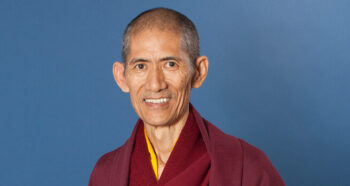


Silence is fascinating because it is equivalent to emptiness, one of the main messages of Buddhism. The simplest way to explain silence is to call it the absence of sound, while emptiness is the absence of everything. In Buddhism we say, “That which is empty, everything is possible. That which is not empty, nothing is possible.” To apply this to the idea of sound, I’d say, “That which is silent, everything is possible.”
Sound is all about ideas. Silence, however, takes you to the next level. If you want to put your ideas into practice, then you need to let silence take over. If I’m talking about the taste of chocolate, my words will give you an idea, but they will not give you the experience. Saying the word chocolate might make you think about it, but only unwrapping the package and placing the candy in your mouth will bring the “aha” moment of satisfaction. Say the word “sweet” and nothing happens. The word sweet isn’t sweet. The experience is when you eat.
In spiritual matters we refer to three practices: study, reflection, and meditation. With these you journey from sound to silence.
Thopa is the Tibetan word for hearing. When you study, you listen to your teacher, read books, get ideas from friends, watch TV. Yet all of these are noise. Even when you read books silently you are mentally talking. Through listening or hearing, you get ideas and concepts.
Sampa means to reflect on, sorting as if through a strainer what to throw out and what to keep. When you start to look very carefully, then you know what to place in the trash.
Gompa, the third and final phase, means to meditate, to get rid of the thoughts and quiet the noise.
In traditional Tibetan practice a young person training to be a monk begins study at the age of seven or eight. When they reach their twenties or thirties they can continue their studies and teach others, or they can disappear into the wilderness (caves, mountains, or remote monasteries) to meditate. Their entire lifetime of learning is then spent contemplating—cut off from civilization and in a world where there is no hustle and bustle—words that imply a cacophony of sounds. This can last years, months, or even a lifetime and gives the inner self a chance to reflect and experience itself.
Silence is embedded in the teachings of the Buddha. In the flower sermon the Buddha held up a lotus in front of hundreds of his disciples. He said nothing. They said nothing. Only his disciple Mahakasyapa responded, and with nothing more than a faint smile. The flower that blooms from mud held infinite meaning for the Buddha. In that moment he said a million things silently.

Khenpo Pema Wangdak became a monk at the age of seven and went on to attend the Central Institute of Higher Tibetan Studies and Sanskrit University. In 1982 he was sent to teach in New York City, becoming the first of his generation of Tibetan teachers to settle in the United States. He founded the Vikramasila Foundation in 1989 to support educational initiatives around the world. In recognition of his humanitarian work, he became the first Tibetan to be awarded the Ellis Island Medal of Honor.
Get the latest news and stories from the Rubin, plus occasional information on how to support our work.